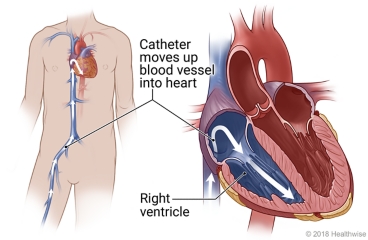Leadless Pacemaker Placement: Before Your Procedure
What is leadless pacemaker placement?

A leadless pacemaker is a small, battery-powered device. It sends
mild electrical signals to your heart to keep it beating normally.
These signals are painless. The pacemaker can help stop the
dizziness, fainting, and shortness of breath caused by a slow heart
rate.
You will get medicine before the procedure. It helps you relax and
helps prevent pain.
Your doctor doesn't need to make any cuts to do the procedure.
Instead, your doctor uses a thin tube called a catheter. The
pacemaker is placed inside the catheter. The doctor puts the
catheter into a blood vessel in your groin. You will get a shot to
numb the skin where the catheter goes in.
Then the doctor moves the catheter through the blood vessel to your
heart. You may feel pressure when the doctor does this. Your doctor
may also have injected a dye into your blood vessel and heart. The
dye shows up on a screen. It helps your doctor see where to move the
catheter and pacemaker.
When the catheter is inside the lower right chamber of the heart
(right ventricle), the doctor moves the pacemaker out of the
catheter. Your doctor attaches the pacemaker to the heart tissue so
that it doesn't move. Flexible hooks may be used. Then the catheter
is removed from your body.
You may spend the night in the hospital, or you may go home the same
day. Your groin may have a bruise and feel sore for a few days.
If you are worried about having a pacemaker, it may help if you
learn about how the pacemaker helps your heart. Talk to your doctor
if you have concerns.
How do you prepare for the procedure?
Procedures can be stressful. This information will help you
understand what you can expect. And it will help you safely prepare
for your procedure.

Preparing for the procedure
|
|
|
|
|
|
|
|
-
Tell your doctor ALL the medicines, vitamins, supplements,
and herbal remedies you take. Some may increase the risk
of problems during your procedure. Your doctor will tell
you if you should stop taking any of them before the
procedure and how soon to do it.
|
|
|
|
|
|
|
What happens on the day of the procedure?
|
|
-
Follow the instructions exactly about when to stop eating
and drinking. If you don't, your procedure may be
canceled. If your doctor told you to take your medicines
on the day of the procedure, take them with only a sip of
water.
|
|
|
-
Follow your doctor's instructions about when to bathe or
shower before your procedure. Do not apply lotions,
perfumes, deodorants, or nail polish.
|
|
|
|

At the hospital
or surgery center
When should you call your doctor?
Current as of: June 24, 2023
Content Version: 14.0
Care instructions adapted under license by your healthcare
professional. If you have questions about a medical condition or
this instruction, always ask your healthcare professional.
Healthwise, Incorporated disclaims any warranty or liability for
your use of this information.